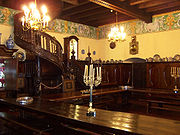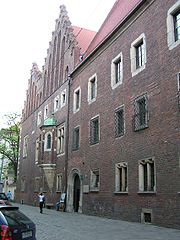
Collegium Maius
Encyclopedia



Kraków
Kraków also Krakow, or Cracow , is the second largest and one of the oldest cities in Poland. Situated on the Vistula River in the Lesser Poland region, the city dates back to the 7th century. Kraków has traditionally been one of the leading centres of Polish academic, cultural, and artistic life...
, Poland
Poland
Poland , officially the Republic of Poland , is a country in Central Europe bordered by Germany to the west; the Czech Republic and Slovakia to the south; Ukraine, Belarus and Lithuania to the east; and the Baltic Sea and Kaliningrad Oblast, a Russian exclave, to the north...
, is the Jagiellonian University
Jagiellonian University
The Jagiellonian University was established in 1364 by Casimir III the Great in Kazimierz . It is the oldest university in Poland, the second oldest university in Central Europe and one of the oldest universities in the world....
's oldest building, dating back to the 15th century. It stands at the corner of ulica Jagiellońska (Jagiellon Street) and ulica Świętej Anny (St. Anne Street).
History
The then 36-year-old university, known at the time as Akademia krakowska ( the Krakow Academy), moved into the building in 1400 after King Władysław II Jagiełło had purchased it with funds bequeathed by his late wife, Queen JadwigaJadwiga of Poland
Jadwiga was monarch of Poland from 1384 to her death. Her official title was 'king' rather than 'queen', reflecting that she was a sovereign in her own right and not merely a royal consort. She was a member of the Capetian House of Anjou, the daughter of King Louis I of Hungary and Elizabeth of...
.
The Collegium Maius was rebuilt in the late 15th century as a late-Gothic structure surrounding a large courtyard bordered with arcades. In 1517 a well was built in the center of the courtyard. Professors lived and worked upstairs, while lectures were held downstairs.
In the 1490s the Collegium Maius counted among its students Nicolaus Copernicus
Nicolaus Copernicus
Nicolaus Copernicus was a Renaissance astronomer and the first person to formulate a comprehensive heliocentric cosmology which displaced the Earth from the center of the universe....
, the Renaissance
Renaissance
The Renaissance was a cultural movement that spanned roughly the 14th to the 17th century, beginning in Italy in the Late Middle Ages and later spreading to the rest of Europe. The term is also used more loosely to refer to the historical era, but since the changes of the Renaissance were not...
astronomer and polymath
Polymath
A polymath is a person whose expertise spans a significant number of different subject areas. In less formal terms, a polymath may simply be someone who is very knowledgeable...
who would revolutionize European ideas about the universe.
Cultural significance
The Collegium Maius Museum features ancient lecture rooms, communal halls, professors’ quarters, a library and a treasury containing rectors'Rector
The word rector has a number of different meanings; it is widely used to refer to an academic, religious or political administrator...
Gothic maces and the Jagiellonian globe. Exhibits also include medieval scientific instruments, globes, paintings, collectibles, furniture, coins and medals.

